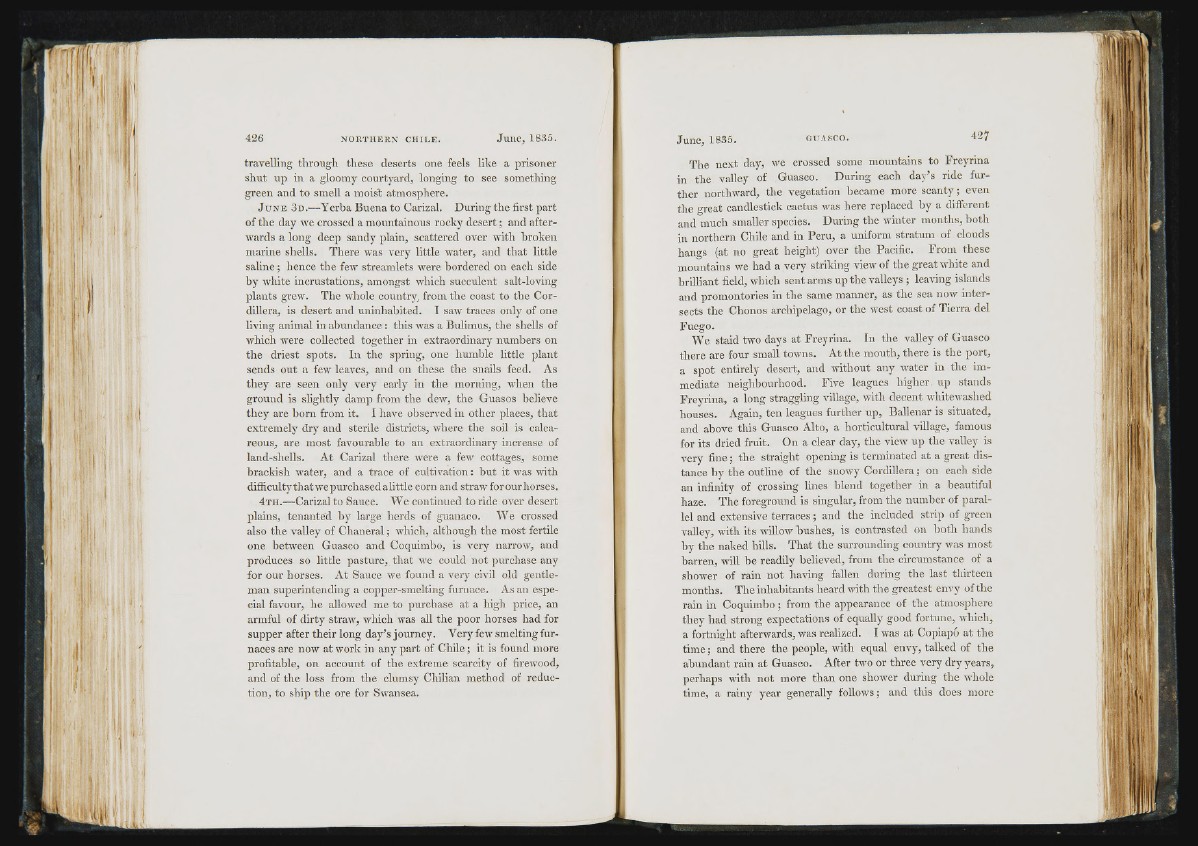
: ft
travelling through these deserts one feels like a prisoner
shut up in a gloomy courtyard, longing to see something
green and to smell a moist atmosphere.
J u n e 3 d .—Yerba Buena to Carizal. During the first part
of the day we crossed a mountainous rocky desert ; and afterwards
a long deep sandy plain, scattered over with broken
marine shells. There was very little water, and that little
saline ; hence the few streamlets were bordered on each side
by white incrustations, amongst which succulent salt-loving
plants grew. The whole country, from the coast to the Cordillera,
is desert and uninhabited. I saw traces only of one
living animal in abundance : this was a Bulimus, the shells of
which were collected together in extraordinary numbers on
the driest spots. In the spring, one humble little plant
sends out a few leaves, and on these the snails feed. As
they are seen only very early in the morning, when the
ground is slightly damp from the dew, the Guasos believe
they are born from it. I have observed in other places, that
extremely dry and sterile districts, where the soil is calcareous,
are most favourable to an extraordinary increase of
land-shells. At Carizal there were a few cottages, some
brackish water, and a trace of cultivation : but it was with
difficultytliatwepurchasedalittle corn and straw forourhorses.
4 t h .—Carizal to Sauce. We continued to ride over desert
plains, tenanted by large herds of guanaco. We crossed
also the valley of Clianeral ; which, although the most fertile
one between Guasco and Coquimbo, is very narrow, and
produces so little pasture, that we could not purchase any
for our horses. At Sauce we found a very civil old gentleman
superintending a copper-smelting furnace. As an especial
favour, he allowed me to purchase at a high price, an
armful of dirty straw, which was all the poor horses had for
supper after their long day’s j ourney. Very few smelting furnaces
are now at work in any part of Chile ; it is found more
profitable, on account of the extreme scarcity of firewood,
and of the loss from the clumsy Chilian method of reduction,
to ship the ore for Swansea.
The next day, we crossed some mountains to Freyrina
in the valley of Guasco. During each day’s ride further
northward, the vegetation became more scanty; even
the great candlestick cactus was here replaced by a different
and much smaller species. During the wiuter months, both
in northern Chile and in Peru, a uniform stratum of clouds
hangs (at no great height) over the Pacific. From these
mountains we had a very striking view of the great white and
brilliant field, which sent arms up the valleys ; leaving islands
and promontories in the same manner, as the sea now intersects
the Chonos archipelago, or the west coast of Tierra del
Fuego.
We staid two days at Freyrina. In the valley of Guasco
there are four small towns. At the mouth, there is the port,
a spot entirely desert, and without any water in the immediate
neighbourhood. Five leagues higher, up stands
Freyrina, a long straggling village, with decent whitewashed
houses. Again, ten leagues further up, Ballenar is situated,
and above this Guasco Alto, a horticultural village, famous
for its dried fruit. On a clear day, the view up the valley is
very fine; the straight opening is terminated at a great distance
by the outline of the snowy Cordillera; on each side
an infinity of crossing lines blend together in a beautiful
haze. The foreground is singular, from the number of parallel
and extensive terraces; and the included strip of green
valley, with its willow hushes, is contrasted on both hands
by the naked hills. That the surrounding country was most
barren, will be readily believed, from the circumstance of a
shower of rain not having fallen during the last thirteen
months. The inhabitants heard with the greatest envy of the
rain in Coquimbo; from the appearance of the atmosphere
they had strong expectations of equally good fortune, which,
a fortnight afterwards, was realized. I was at Copiapo at the
time; and there the people, with equal envy, talked of the
abundant rain at Guasco. After two or three very dry years,
perhaps with not more than one shower during the whole
time, a rainy year generally follows; and this does more